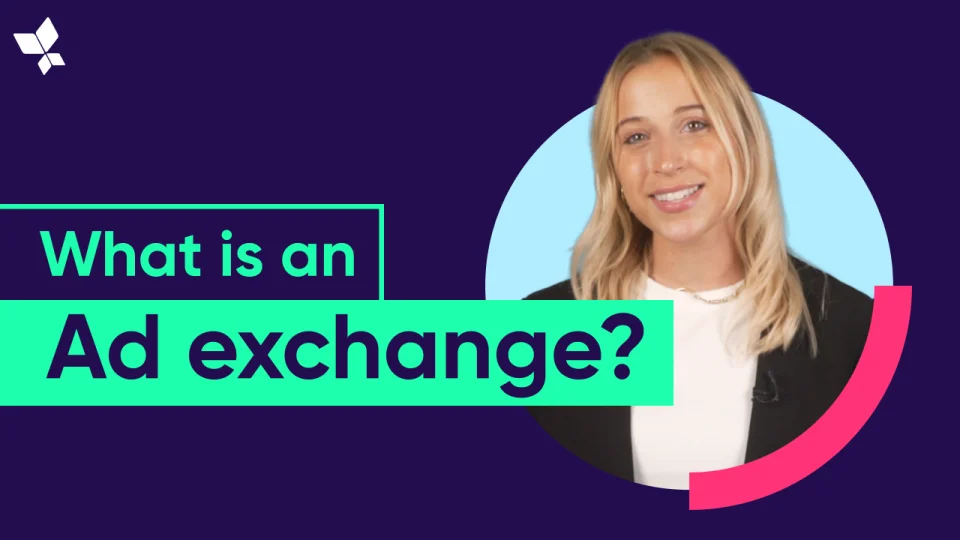
Ad exchange
An ad exchange is a digital marketplace, where advertising inventory is bought and sold.
What is an ad exchange?
A digital marketplace, where advertising inventory is bought and sold across websites, mobile sites and mobile apps.
Publishers – such as website or app owners – offer advertising space for advertisers – such as agencies or ad networks, allowing them to buy ad space and publish display, video and mobile ads.
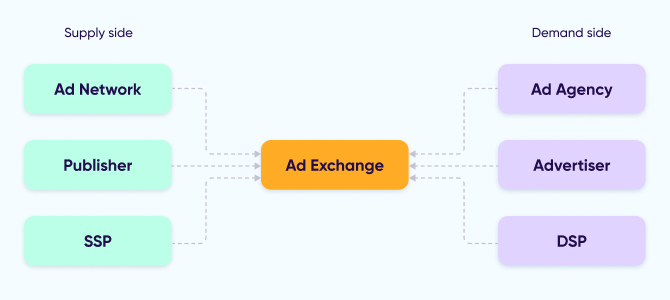
Who uses it?
Virtually anyone can buy and sell impressions on an ad exchange. Publishers use an ad exchange to sell their ad space, while advertisers or agencies use them to purchase ad space.
Why do marketers use ad exchanges?
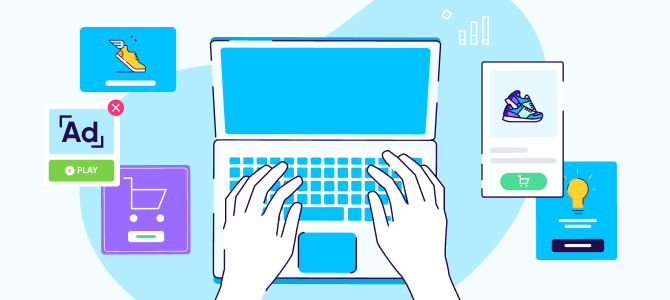
It’s essentially a more efficient and transparent way to buy and sell digital advertising.
As the mobile landscape has evolved and grown, buyers and sellers have leveraged the ad exchange to optimize processes and maximize profit-making. The actual ad exchange takes place using sophisticated algorithms, allowing publishers to get the best price for their ad real estate, and advertisers to reach out their valued target audience at the right time and with the most relevant context.
Exchanges enable advertisers to easily buy ads across a range of websites, mobile sites and mobile apps at once, as opposed to negotiating buys directly with specific publishers.
How do ad exchanges work?
To have a better grasp of the role of the ad exchange in the digital marketing ecosystem, let’s first identify the key players and see how they interact with each other:
Ad networks – and how they differ from an ad exchange
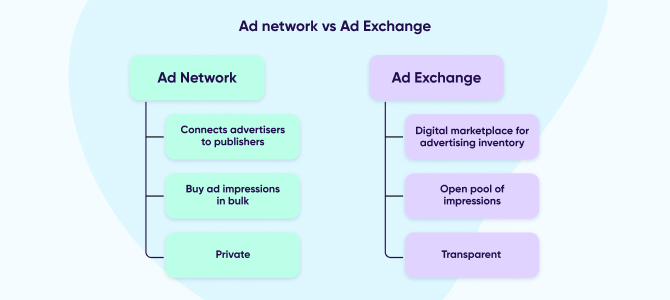
An ad network connects advertisers to publishers that offer ad inventory. The key function of an ad network is aggregating ad supply from publishers, and matching it with advertisers’ demand.
Although the ad exchange and ad network seem to be performing the same role, they’re not. Ad Networks collect digital ad inventory from a list of publisher sites or buy ad impressions in bulk from the ad exchange, sort them through and then resell them to advertisers. Since advertisers do not have enough time or resources for filtering available inventory, Ad Networks simply do it for them.
They group inventory according to specific parameters such as pricing, scale, or audience segments (demographics, geography, language, interests, consumer behavior, etc.). Some Ad Networks are focused on coverage and quantity, while others specialize in the quality of ad slots they offer.
So if an ad exchange is an open pool of impressions, an Ad network is a closed group of privately traded ads. Ad exchange, in that sense, offers more transparency to buyers, because they can see exactly how much each impression is being sold for, with no intermediary players.
Some terminology:
Demand Side Platform (DSP)
A DSP is a technology used to purchase advertising automatically. DSPs are most often used by advertisers and agencies to help them buy display, video, mobile and search ads.
Supply Side Platform (SSP)
An SSP is a technology used to sell advertising automatically. SSPs are most often used by online publishers to help them sell display, video and mobile ads.
How does all of this come together on the ad exchange?
In many ways, what happens in the ad exchange is similar to an auction, enabling advertisers to reach their audiences across a wide pool of publishers.
Advertisers and agencies typically connect to an ad exchange using a DSP, while publishers usually make impressions available on an exchange through an SSP.
What actually happens during real-time bidding (RTB)

The moment a user lands on a web or in-app page, an ad impression is triggered for auction on the exchange. The DSP can analyze data from multiple sources – such as the user’s mobile identifier, time of day, device type, ad position, demographics and purchasing behavior – to figure out whether to bid on the impression and how much to bid for it.
The most amazing part of this whole buying and selling process is that everything happens with a blink of an eye.
RTB is based on a fully automated process that calculates the price of the advertising space and inventory in real-time, depending on supply and demand factors. Advertisers can bid on ad space with a specific number of ad impressions, and then the ad belonging to the highest bidder is displayed for an impression.
Types of exchanges and key players
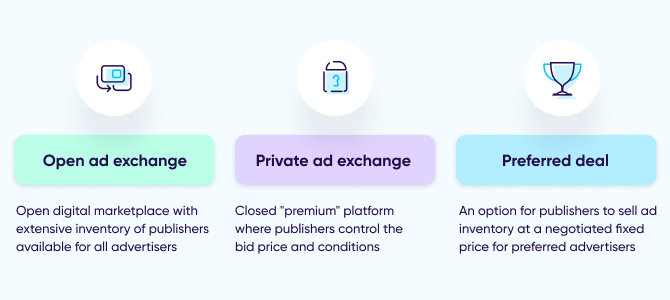
1. Open ad exchange / Public Marketplace / Open Auction
The above describe an open digital marketplace with extensive inventory of publishers available for all advertisers. Despite offering a broad list of publishers, advertisers using an open ad exchange don’t have detailed information about publishers, as is the case with a private marketplace.
Advertisers looking for wider publicity choose an open ad exchange.
However, with tens of billions of impressions flowing through open Ad Exchanges every day, there is a growing and grounded concern among advertisers and publishers regarding digital ad fraud. For this reason, private marketplaces are becoming more popular, as they are considered safer and more transparent.
2. Private ad exchange / Private Marketplace (PMP)
A PMP is a closed, “premium” platform that enables the publisher to control which advertisers can bid, at what price and under which conditions. Each private ad exchange is run by an individual publisher that personally invites selected advertisers to the PMP.
The publisher can also block Ad Networks and other third-party members from giving access to its pool of impressions. A private ad exchange allows brands and publishers to set up direct relationships with advertisers and agencies, meaning negotiations might be more time-consuming in comparison to an open ad exchange.
3. Preferred deal
A preferred deal is an option for a publisher to sell digital ad inventory at a negotiated fixed price for preferred advertisers. Preferred deals give the publisher a stable revenue stream through a controlled transaction system, while advertisers benefit from stable CPM prices and having access to an exclusive inventory.
A few key ad exchanges:
- DoubleClick (Google)
- AppNexus
- OpenX
- Rubicon Project Exchange (Magnite)
- Right Media Exchange (Yahoo)
- Smaato – mobile focused
- MoPub (Twitter) – mobile focused
Leveraging mobile attribution to optimize ad exchange activities
As mobile advertisers, you can gain high-value insights into the effectiveness of your ad exchange buys using attribution data. It equips you with authoritative, indisputable data that empowers you to allocate your budget in a smarter way, and enables you to optimize your app’s performance, ROAS, and LTV.
So if you’re exploring your ad exchange options, know there’s a bullet-proof way to make the most of your ad spend, by pinpointing your most valued and least valued digital investments.
Key takeaways
- An ad exchange is like a pool of ad impressions. Publishers drop their ad impressions into the pool in the hope advertisers will grab the bait, and then advertisers choose the impressions they wish to purchase.
- It helps make the process of buying and selling ad space more effective and transparent, while maximizing profitability. Publishers get the best price for their ad space, and advertisers reach out to their valued target audience at the right time and with the most relevant, data-driven context.
- An ad exchange is capable of analyzing real-time data from multiple sources – including users’ mobile identifier, time of day, device type, ad position, demographics and purchasing behavior – to determine whether to bid on the impression and how much to bid for it.
- It enables advertisers to easily buy ads across a range of sites at once, as opposed to negotiating buys directly with specific publishers. In an increasingly complex and dynamic advertisement market, an ad exchange offers a more efficient and transparent solution for buying and selling digital advertising.
